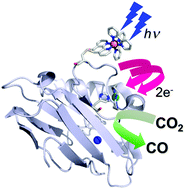当前位置:
X-MOL 学术
›
Chem. Commun.
›
论文详情
Our official English website, www.x-mol.net, welcomes your
feedback! (Note: you will need to create a separate account there.)
A photoactive semisynthetic metalloenzyme exhibits complete selectivity for CO2 reduction in water†
Chemical Communications ( IF 4.3 ) Pub Date : 2018-04-10 00:00:00 , DOI: 10.1039/c8cc01297k Camille R Schneider 1 , Anastasia C Manesis , Michael J Stevenson , Hannah S Shafaat
Chemical Communications ( IF 4.3 ) Pub Date : 2018-04-10 00:00:00 , DOI: 10.1039/c8cc01297k Camille R Schneider 1 , Anastasia C Manesis , Michael J Stevenson , Hannah S Shafaat
Affiliation

|
A series of artificial metalloenzymes containing a ruthenium chromophore and [NiII(cyclam)]2+, both incorporated site-selectively, have been constructed within an azurin protein scaffold. These light-driven, semisynthetic enzymes do not evolve hydrogen, thus displaying complete selectivity for CO2 reduction to CO. Electrostatic effects rather than direct excited-state electron transfer dominate the ruthenium photophysics, suggesting that intramolecular electron transfer from photogenerated RuI to [NiII(cyclam)]2+ represents the first step in catalysis. Stern–Volmer analyses rationalize the observation that ascorbate is the only sacrificial electron donor that supports turnover. Collectively, these results highlight the important interplay of elements that must be considered when developing and characterizing molecular catalysts.
中文翻译:

光活性半合成金属酶对水中二氧化碳还原具有完全选择性†
一系列含有钌发色团和 [Ni II (cyclam)] 2+的人工金属酶(两者均选择性地掺入)已构建在天青蛋白支架内。这些光驱动的半合成酶不会放出氢气,因此对 CO 2还原成 CO 表现出完全选择性。钌光物理中主导着静电效应而不是直接激发态电子转移,这表明分子内电子从光生 Ru I转移到 [Ni II (cyclam)] 2+代表催化的第一步。斯特恩-沃尔默分析合理化了这一观察结果,即抗坏血酸是唯一支持周转的牺牲电子供体。总的来说,这些结果强调了在开发和表征分子催化剂时必须考虑的元素之间的重要相互作用。
更新日期:2018-04-10
中文翻译:

光活性半合成金属酶对水中二氧化碳还原具有完全选择性†
一系列含有钌发色团和 [Ni II (cyclam)] 2+的人工金属酶(两者均选择性地掺入)已构建在天青蛋白支架内。这些光驱动的半合成酶不会放出氢气,因此对 CO 2还原成 CO 表现出完全选择性。钌光物理中主导着静电效应而不是直接激发态电子转移,这表明分子内电子从光生 Ru I转移到 [Ni II (cyclam)] 2+代表催化的第一步。斯特恩-沃尔默分析合理化了这一观察结果,即抗坏血酸是唯一支持周转的牺牲电子供体。总的来说,这些结果强调了在开发和表征分子催化剂时必须考虑的元素之间的重要相互作用。











































 京公网安备 11010802027423号
京公网安备 11010802027423号